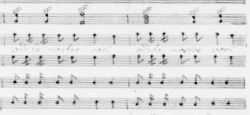This essay is the second of a series devoted to changing-note schemata, a type of dichotomous schema with a treble and/or a bass whose melodic shape look like a gruppetto or a musical turn (~). In this essay, I will discuss the schema that Robert O. Gjerdingen has labelled the Aprile, after the Neapolitan-trained soprano castrato Giuseppe Aprile (1732–1813). (Wolfgang Amadé Mozart heard Aprile sing in Naples, Bologna and Milan in 1770 and wrote the following to his sister in a letter of 26 January 1770: “Primo uomo, Aprile, who sings well, and has a fine even voice”. And in a letter of 5 June 1770 again to his sister, he states that Aprile sings “incomparably”.)
An Aprile is a dichotomous schema that features a ➊–➐…➋–➊ treble line and can be set with several counterpoints in the bass.
To facilitate the reading of this essay, I use Robert Gjerdingen’s black-circled figures to indicate scale steps in an upper part (e.g. ➍–➌) and white-circled figures to indicate scale steps in the bass (e.g. ⑦–①). And I add an accidental to a figure when the specific designation of a diatonic or a chromatically altered scale step is required, although this symbolized notation can differ from the actual one. The list below should suffice to make the system of indications clear. Regardless of the mode,
♭③ always refers to the scale step a minor third above ①
③ always refers to the scale step a major third above ①
♭⑥ always refers to the scale step a minor second above ⑤
⑥ always refers to the scale step a major second above ⑤
♭⑦ always refers to the scale step a major second below ①
⑦ always refers to the scale step a minor second below ①
Term and Interpretation of the Aprile
The term and interpretation of the Aprile come from Robert O. Gjerdingen. He defines an Aprile as a proposta schema that comprises two dyads, as does the Meyer. In fact, both schemata share the first dyad with a ➊–➐ treble line but have a different second dyad. While the Meyer has ➍–➌ treble line in the second dyad, that dyad in the Aprile consists of ➋–➊.
Like the Meyer, the ➊–➐…➋–➊ treble line of the Aprile can
- include suspensions during stages 2 and/or 4
- have several counterpoints.
The Aprile with a ①–②…⑦–① Bass Line
A first possible counterpoint to the ➊–➐…➋–➊ treble line of the Aprile is the ①–②…⑦–① bass line, that is, the melodic inversion of the treble line making the second dyad into a clausula cantizans. Johann Baptist Vanhal (1739–1813), a Czech composer who lived and worked in Vienna, starts the Credo of his Mass in C major W. XIX:C2 with this type of Aprile in a four-part texture:

To begin the Qui tollis (in C minor) of another mass —a Missa solemnis— in C major, Vanhal writes a four-part Aprile also with a ①–②…⑦–① bass line, adding suspensions to stages 2 and 4 (I have indicated the suspensions with a blue arrow):
- the sixth of the 6♮/4/3 chord of stage 2 is delayed by the seventh, resulting in a 7/4/3 sonority at the start of bar 2
- both the octave and the third of the triad of stage 4 are delayed by respectively the ninth and the fourth, resulting in a temporary 9/4 sonority at the start of bar 4.

Note
- the anticipation between each suspension and its resolution
- how this example illustrates well how closely the Aprile and the Meyer are related, sharing the first dyad, as mentioned above: while the soprano produces the Aprile treble line (➊–➐…➋–➊), the first violin produces the Meyer treble line (➊–➐…➍–➌).
Joseph Haydn writes a similar four-part Aprile, in major, for the four-part choir entry of the chorus that concludes the first part of his oratorio Il ritorno di Tobia Hob. XXI:1, including the same suspensions as in the example above (but without the anticipations). (I have indicated the suspensions with a blue arrow.)

The Aprile with a ①–②…⑤–① Bass Line
The third structural note of the bass line could also be ⑤ instead of ⑦, resulting in a stronger cadential closure of the Aprile (clausula basizans). Mozart begins the second movement (in C minor) of his Sinfonia concertante in E flat major KV 364 with such an Aprile:

The first example of an Aprile that Gjerdingen gives in his book Music in the Galant Style, by Giuseppe Aprile himself, is one with this bass line:

The Aprile with a ①–②…④–③ Bass Line (Jupiter)
The second dyad of an Aprile can also be set as a clausula altizans, resulting in a ①–②…④–③ bass line. This bass line is actually the melodic essence of another changing-note schema that Gjerdingen has called the Jupiter. The second theme (in B flat major) of the second movement (in E flat major) of Mozart’s symphony in G minor KV 550 presents an Aprile with a Jupiter bass:

Note that stages 2 and 4 are foreseen with a suspension in the upper part, resulting twice in a 7–6 suspension.
The Aprile with a ①–⑤…⑤–① Bass Line
The treble line of an Aprile can also be accompanied with a ①–⑤…⑤–① bass line. An example of this type of Aprile —a straightforward version without suspensions— can be seen and heard in bars 3–4 of Mozart’s Veni Sancte Spiritus in C major KV 47:

As this example illustrates, the treble lines of the Aprile (in the first violin), of the Meyer (in the first oboe) and of the paired Do-Re-Mi (in the first trumpet and horn) can all three sound simultaneously above a ①–⑤…⑤–① bass line.
The Aprile with a ①–⑤…⑤–(④–)③ Bass Line
The conclusion of an Aprile can be made less final by changing the clausula basizans into a clausula altizans. Haydn penned such an Aprile to open the slow movement (in B minor) of his symphony in B major Hob. I:46:

Note
- the ‘extra’ augmented sixth chord in between ① and ⑤ on the last eighth note of bar 1
- how the bass imitates twice the motive of the first violin (bars 2 and 4).
The Aprile with a ①–⑤…⑦–① Bass Line
Another way of making the conclusion of an Aprile less final is by changing the clausula basizans into a clausula cantizans. The B-part of the aria Se mai senti spirarti sul volto from Gluck’s opera La clemenza di Tito opens with such an Aprile:

(Four bars later, Gluck reuses the same music in C minor (not shown).)
Note
- that this Aprile has been set with suspensions in the treble, a 4–3 suspension during stage 2 and a 9–8 suspension during stage 4
- that, while the first violin simultaneously plays a Meyer with the soprano singing the Aprile, one is more likely to hear an upper violin part that doubles the soprano throughout due to the fact the second violin takes over the colla parte function, playing the upper part from the second beat of bar 103
- that, while the second violin plays a paired Mi-Re-Do (➌–➋…➋–➊),the second dyad appearing an octave higher than usual, one is more likely to hear a lower violin part that produces the treble line of another changing-note schema, the Pastorella.
The Aprile with a ③–④…④–③ Bass Line
While all the versions of an Aprile we saw until now have a bass line that starts on ①, the bass can also start on ③. The only version of an Aprile with a bass starting on ③ I came across has a ③–④…④–③ bass line:

(A bass line entirely in parallel sixths with the Aprile treble line —③–②…④–③— would also work perfectly, but I have yet to come across this version in 18th-century repertoire yet. If you have, please let me know.)
Interesting in this setting is that not stages 2 and 4 but stages 1 and 3 are foreseen with on-beat dissonances, in both cases with a 7–6 appoggiatura.
The Aprile Treble Line Used as a Bass Line
While all the versions of an Aprile we saw until now presented the melodic essence of the Aprile in the treble line, it can also occur in the bass. Mozart does this by inverting (almost literally) both hands of the theme of the minuet discussed above for the recapitulation:

For more repertory examples of the Aprile check out the following video by John Rice:
Further Reading (Selection)
Gjerdingen, Robert O. Music in the Galant Style (New York: Oxford University Press, 2007).
Gjerdingen, Robert O. Child Composers in the Old Conservatories — How Orphans Became Elite Musicians (New York: Oxford University Press, 2020).
IJzerman, Job. Harmony, Counterpoint, Partimento: A New Method Inspired by Old Masters (New York: Oxford University Press, 2018).
